Posted by Anita on 03.11.09 11:49 AM
 Two weekends ago, I nearly lost a toe.
Two weekends ago, I nearly lost a toe.
I’d been rooting around in the upstairs freezer (yes, we have two — doesn’t everyone?), looking for some mysterious recipe ingredient, when the Jenga pile that is the meat shelf gave way. Luckily, I jumped back just in time to avoid an avalanche of frozen bricks, but it was a near thing.
With no time to spare, I shoved everything back in as neatly as I could, and added “re-organize the freezer” to my to-do list. It took me a while to get there, but one cold and cloudy morning, I tackled this long-overdue task. I took everything out of both freezers, inventoried the contents, and put it all back in the least-precarious and most-logical way possible. Admiring my newly tidy spaces, I felt so virtuous.
But as I surveyed the inventory list, that virtuous feeling vanished. How in the world had we managed to squirrel away enough food to fill two standard freezers? Just the list of our frozen fodder filled an entire letter-size page!
Happily, this is one embarrassing problem we can literally eat our way out of.
 I sat down and quickly mapped out 14 meals we could easily make by combining two or more components of the freezer. (Beef plus chorizo plus buns equals Sloppy Joes. Beans plus pork plus sausage equals Cassoulet.) And that wasn’t even counting the dozen or so ready-to-eat meals — like beef stew, coq au vin, and chili — that we’d set aside. I quickly realized we could go for weeks, eating very well without buying anything but fresh vegetables.
I sat down and quickly mapped out 14 meals we could easily make by combining two or more components of the freezer. (Beef plus chorizo plus buns equals Sloppy Joes. Beans plus pork plus sausage equals Cassoulet.) And that wasn’t even counting the dozen or so ready-to-eat meals — like beef stew, coq au vin, and chili — that we’d set aside. I quickly realized we could go for weeks, eating very well without buying anything but fresh vegetables.
So, just in time for Lent — which we don’t celebrate, but definitely respect — I floated a new house rule: No new meat until we eat down our glut. Which, if we’re diligent, I predict will happen right about Easter Sunday. Cameron happily agreed, with one exception: Bacon. There will be bacon. Because it’s just not the weekend without everyone’s favorite cured meat.
So far, I have to say that our experiment’s been a wild success. We’re clearing out the freezers — I can see shelves! — while we save time and money, which are never abundant, but seem to be in even shorter supply this month. The oldest thing we’ve eaten so far? A bag of Rick Bayless’s ancho beef chili dated 6/07, which tasted surprisingly fine.
One of the winningest put-togethers so far is a new variation on an old favorite: chicken pot-pie. With a bag of pie-crust scraps begging to be used, we decided to take a break from our usual biscuit-topped recipe. I’m glad we did, because the rich, warm flavor of the sherry and the savory pop of mushrooms in this version make it a worthy variation.




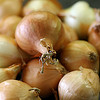
Chicken Pot Pie
— adapted from Kitchen Sense
3-1/2 cups cubed cooked chicken (a generous pound by weight)
1/2 cup (1 stick) unsalted butter
1 medium onion, chopped
1 medium carrot, sliced
1 celery stalk, chopped
6oz small mushrooms, quartered
1 tsp thyme leaves (stripped from the stem)
1/3 cup peas (not in season yet, so we omitted)
freshly ground black pepper
1/2 cup sherry or dry white wine
5T all-purpose flour
2 cups poultry stock
1 bay leaf
1T chopped flat-leaf parsley
1/2 recipe of your favorite pie crust (enough to cover a 9-inch pie pan)
1 small egg, beaten with 1 T cold water
Preheat the oven to 425°F.
Melt 3T of the butter in a large skillet over medium heat. Saute the onion until soft, the add the carrot and celery and continue cooking for another 3 to 5 minutes, until soft. Add the mushrooms and thyme and cook until the mushrooms give up their liquid. Add the peas, 1 tsp of salt, and pepper to taste; stir and cook for a couple of minutes. Deglaze the pan with half of the sherry; remove the cooked vegetables and their juices to a bowl and set aside.
Melt the remaining butter in the skillet, then whisk in the flour to make a roux. Cook for 3 to 5 minutes until the paste takes on a blonde color, Whisk in the stock and the remaining sherry, then add the bay leaf, thyme, 1 tsp salt, and pepper to taste. Simmer until thickened.
Add the cooked chicken and sauteed vegetables to the sauce. Transfer the mixture to a 1-1/2 quart baking dish (such as a deep-dish pie pan) and set aside in a warm spot near the oven.
Roll out the pie dough about 1 inch larger than the diameter of the baking dish and about 1/4-inch thick. Place the dough atop the pie filling, and press the overlap to the outside of the dish. Place the filled and covered pie on top of a rimmed baking sheet. Brush with the beaten egg, then make a few slits to allow steam to escape.
Bake for 20 minutes at 425°F until the crust has risen and begun to take on color. Reduce the heat to 350°F and bake for another 15 to 20 minutes, until the crust is a deep golden brown. Remove from the oven and serve.
Dark Days challenge, locavore, recipes
16 Comments »




Posted by Anita and Cameron on 03.03.09 7:44 PM
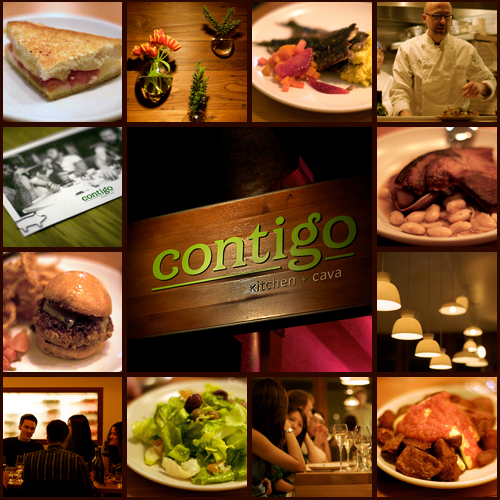
Meeting a friend you’ve only known online can be a nervous affair. Will you get along? Will they be cool in person? What if they have a funny voice and a big nose? When the moment comes and they turn out to be even more fabulous than you’d hoped, the elation feels like a glassful of Champagne… or cava in this case.
Elation was definitely the order of the evening Saturday night when we finally met Contigo, the new Spanish restaurant from our friend, Chef Brett Emerson. If you’re a fan of his blog, In Praise of Sardines, you’re probably familiar with the saga of Contigo’s opening, from the thrill of Brett’s snagging of a rare new-restaurant permit in Noe Valley, through the agony of multiple construction delays. I don’t know how Brett feels, but after tasting his food at a friends-and-family dinner before Contigo’s formal opening, I think all the drama was all worth it.
The space is beautiful, simultaneously contemporary and cozy. It’s not large, but it feels expansive thanks to five distinct dining zones — chef’s counter, lower dining room, cava bar, upper dining room, and a heated, covered outdoor patio surrounded by herb gardens.
Contigo’s ingredients are locally sourced, but not slavishly so — there’s jamón from Spain (and Iowa), alongside meat and vegetables from the usual assortment of local farms. And the food on the plate is every bit the equal of its gorgeous environment. We had a devil of a time deciding what to order; everything sounded appealing. Like an Iberian version of our favorite SPQR, Contigo offers an assortment of small pica-pica plates ($8 each, or $21 for three). Venerable tapas like crisp patatas bravas and marinated sardines take their place alongside an assortment of salads with Spanish twists. In the latter category, we loved the remojon: salt cod, oranges, and olives atop white radicchio.
We tried a couple of larger platillos as well. The juidones a la segovia were a dreamy assortment of delectable pork parts (belly, ears, yum!) atop creamy butter beans. The chorizo-y txistorra burger was fabulous, but be ready to share it with a friend; it’s too good to miss, but a little too rich to eat as an entree.
We weren’t sure how we managed to save room for dessert, but we were happy we did. We made short work of the not-too-sweet almond cake, filled with a dollop of pastry cream and a schmear of olallieberry preserves, a sweet nod to the restaurant’s history.
Contigo opens tonight, and there’s sure to be a line; reservations are accepted only for parties of 6 or more. But there’s a stand-up drink rail along the entryway, where you can enjoy a glass of cava and a nibble or two while watching the cooks work their magic in the beautiful open kitchen.
Contigo Kitchen + Cava
1320 Castro Street (x 24th Street)
San Francisco, CA 94114
415.285.0250
Noe Valley, other blogs, restaurants
9 Comments »




Posted by Anita on 02.24.09 9:40 PM
 Now, I don’t know where you go for good Cajun and Creole recipes, but my first (and last) source is Chuck Taggart’s fabulous Gumbo Pages. Chuck’s site covers a whole lot more than just food. It’s a true mélange of everything that’s wonderful about the culture of New Orleans and the surrounding area — recipes, dining recommendations, cocktails, music, and so much more.
Now, I don’t know where you go for good Cajun and Creole recipes, but my first (and last) source is Chuck Taggart’s fabulous Gumbo Pages. Chuck’s site covers a whole lot more than just food. It’s a true mélange of everything that’s wonderful about the culture of New Orleans and the surrounding area — recipes, dining recommendations, cocktails, music, and so much more.
A native New Orleanian, Chuck saved our collective asses at Tales of the Cocktail last year: You pretty much couldn’t leave the Monteleone without running into a cocktail blogger clutching a printout of Chuck’s French Quarter restaurant recommendations; it was the most-viewed page on the Tales Blog, gathering more hits than all the other pages put together. Uh-huh.
 But back to the food. Over the years — even before we’d had the pleasure to make his acquaintance — we’ve used Chuck’s recipes for everything from turkey gumbo to creole hot sausage to dirty rice, all with uniformly excellent results.
But back to the food. Over the years — even before we’d had the pleasure to make his acquaintance — we’ve used Chuck’s recipes for everything from turkey gumbo to creole hot sausage to dirty rice, all with uniformly excellent results.
For our Mardi Gras celebration, we made Dee Gautreau’s World Championship Jambalaya. Because we just don’t feel complete without pork, we took the liberty of adding andouille sausage. (A quick chat with Chuck revealed that sausage was likely in the original, but somehow disappeared from the printed recipe.)
No offense meant to the original recipe, but we’ve made a few minor tweaks to make things a little clearer. I’m sure any Louisiana native would know exactly what Dee meant, but there’s a fair bit of ambiguity there for anyone who wasn’t lucky enough to grow up watching jambalaya being made on a regular basis. You’ll see in the photos that I’ve halved the recipe; it still made four exceptionally generous servings.




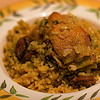
Championship Jambalaya
– adapted from Gumbo Pages
3-to-4 pound chicken, cut into 8 serving pieces (with neck, back, and wingtips reserved)
6-1/2 cups water
1/4 cup cooking oil
3/4 pound andouille sausage, sliced 1/2-inch thick
3 medium white onions, chopped
1 tablespoon salt, or to taste*
2-1/2 teaspoons granulated garlic
1 cup sliced green onions
1/2 cup chopped green peppers
1/2 cup chopped celery
1/4 teaspoon black pepper
Red pepper to taste*
2 tablespoons Louisiana hot sauce (such as Crystal)
3 cups uncooked long-grain rice
Place the chicken neck, back, and wingtips in a saucepan with 6-1/2 cups of water. Bring to a boil, then reduce heat and simmer, covered, while prepping the rest of the jambalaya.
Heat the oil in a heavy Dutch oven over medium heat. When the oil is hot but not smoking, add the chicken parts, skin side down. Fry, without disturbing the chicken, until the skin is a nice golden brown, then turn to brown the other sides equally well. Remove the chicken from the pan and set aside in a warm place near the stove.
Pour off the oil, leaving just enough to coat the bottom of the pan. Add the chopped onions and cook until golden brown, adding a little water if necessary to keep sticking to a minimum. Add the andouille and saute until the fat begins to render. Return the chicken to the pan with the sausage and onions.
Remove the neck, back, and wingtips from the quick broth. Measure the remaining liquid in a heatproof measuring cup, add enough water to make 6 cups, and add this liquid to the sausage/chicken pan. Note the liquid level in the pan; this will be important later.
Add the remaining ingredients except the rice to the pot, and simmer, well covered, until the chicken is cooked through (10 to 15 minutes). Check the liquid level, and add water to return it to the same point it was before simmering, if necessary. Bring back to a rolling boil, and add the rice. Reduce heat to a slow simmer and cook, uncovered and without stirring, for 10 to 15 minutes, until the water level is below the rice. Turn the rice (see notes below), reduce heat to low, and cover with a tight-fitting lid; cook for 15 minutes until the rice is tender. Turn the rice again, turn off the heat, and let the rice steam on the warm burner for 10 minutes more.
* The amount of salt and red pepper needed will depend on the age and strength of your spice, as well as the seasoning in your andouille. I used 1/2 tsp of cayenne pepper for a medium-hot result.
———
Chuck’s jambalaya notes:
– This recipe produces a brown-style jambalaya rather than the red tomato-based jambalayas you see in New Orleans.
– Jambalaya should never be stirred. Turn, rather than stir, to prevent the grains of rice from breaking up, scooping from the bottom of the pot.
Dark Days challenge, holidays & occasions, other blogs, recipes
7 Comments »




Posted by Anita on 02.22.09 8:54 PM
 It’s such a treat to travel around the country (and the world), enjoying all sorts of things that we don’t get here in San Francisco, so we usually put our locavore ways on hiatus when we’re on the road. Occasionally, we’re able to enjoy the best of both worlds, either by visiting a restaurant where the chef sources his ingredients locally, or by shopping for local ingredients and cooking our own meal.
It’s such a treat to travel around the country (and the world), enjoying all sorts of things that we don’t get here in San Francisco, so we usually put our locavore ways on hiatus when we’re on the road. Occasionally, we’re able to enjoy the best of both worlds, either by visiting a restaurant where the chef sources his ingredients locally, or by shopping for local ingredients and cooking our own meal.
But during our Seattle trip over President’s Day weekend, we did one better: We wrangled an invitation up to the (Not So) Urban Hennery for dinner with Laura and her husband Mike.
Despite a persistent drizzle that followed us up I-5 from the city, we arrived in Arlington with just enough sunlight left for a quick farm tour. We put on our boots and headed out to visit the hens. As soon as they saw us (or, really, Laura… she’s definitely at the top of their pecking order!), the girls started up with such a symphony of cackles, chortles, and clucks that we couldn’t help but laugh. They know that the bag in Laura’s hand is full of kitchen scraps, and I suspect they have an idea that there’s cracked corn on offer, too.
As the light waned, we watched Jake and Sam play in the yard as the chickens devoured the goodies Laura had brought them. (Talk about sustainability! Table scraps in, eggs out.) We talked about the plans for the rest of the acreage behind the house, admired Mike’s new fence, and then retreated into the warm kitchen for a snack of local cheeses and a basket of homemade crackers, along with some locally produced hard cider.
 We gathered around the table in the stylishly cozy dining room for an all-local — and pretty much all-homegrown — supper of home-farmed chicken (naturally!) grilled to golden perfection by Mike, along with local wines, pan-braised purple carrots, and a stunning salad of garden spinach topped with local hazelnuts and dried cranberries. It was all delicious, but my favorite part was an amazingly simple potato gratin that showcased Laura’s earthy home-grown potatoes.
We gathered around the table in the stylishly cozy dining room for an all-local — and pretty much all-homegrown — supper of home-farmed chicken (naturally!) grilled to golden perfection by Mike, along with local wines, pan-braised purple carrots, and a stunning salad of garden spinach topped with local hazelnuts and dried cranberries. It was all delicious, but my favorite part was an amazingly simple potato gratin that showcased Laura’s earthy home-grown potatoes.
The recipe — which Laura’s adapted over the years from Nigel Slater’s Appetite — calls for what the author rightly calls an “almost obscene quantity of cream”. Laura says she’s had relatives refuse to eat it after they watched her make it! But really, without any cheese or extra butter, it’s probably not much more decadent than the gratin that you likely already call your favorite. The recipe serves 6 at least, maybe 8 (unless they’re shameless potato gluttons like me).
Back home amid the rain and the beginnings of our spring-cleaning project, we decided to make a whole batch just for the two of us — they’re that spectacular. “They’re even better left over,” says Laura, “Especially if you warm them back up in the oven with a bit of foil over the top.”





Dreamy Potato Gratin
– adapted from Appetite
2 pounds potatoes (about 3 large)
1/2 medium onion (or a leek), sliced very thin
4 cloves garlic, minced
salt & pepper to taste
1 to 2 pints heavy cream, as needed*
Preheat the oven to 400°F.
Peel potatoes and slice thin (about 1/8-inch or 3mm). Toss with the sliced onion and minced garlic, and salt and pepper to taste. Layer the mixture in a well-buttered 9×9 pan and top with enough cream to come halfway up the top layer of potatoes but not submerge them completely. Sprinkle with a little more salt and pepper.
Put the baking pan on top of a rimmed cookie sheet as insurance against a huge oven mess in case of bubbling over. Bake in the preheated oven, pressing the potatoes down into the liquid when the cream starts to expand. At the 20-minute mark, press the potatoes into the cream again and reduce the oven temperature to 350°F.
When the gratin starts to color and smell good — about the hour mark — check the potatoes for doneness by inserting a knife into the center. Continue to bake until the potatoes are no longer at all crunchy but not yet mushy. If the top begins to get too brown, move the gratin to a lower rack and turn the temperature down to 300°F. When done, remove from the oven and let sit for a few minutes to allow the gratin to set.
* The quantity of cream needed will depend on how close you’re able to get your potatoes to the 2-pound mark, how much potato you lose to peeling and trimming, and the exact dimensions of your pan. Laura’s dish is closer to 10×10 and fairly deep, so she uses 2 whole pints. 1 pint was perfect in my standard 2-quart 9×9 pan.
Dark Days challenge, locavore, other blogs, recipes, Seattle
9 Comments »




Posted by Anita on 02.20.09 1:48 PM
 It’s always an thrill to discover that one of your idols admires your work, and a huge honor for another blogger to trust you with their “baby”. So you can imagine my elation — and perhaps even sense my panic? — when the lovely Tartelette asked me to guest-post over at her place this week.
It’s always an thrill to discover that one of your idols admires your work, and a huge honor for another blogger to trust you with their “baby”. So you can imagine my elation — and perhaps even sense my panic? — when the lovely Tartelette asked me to guest-post over at her place this week.
I’m beyond flattered to be asked to contribute to Tartelette’s incredible site, winner of Food Blog of the Year in the 2008 Well Fed Awards and — just this week! — placed at #43 on the Times Online list of the World’s 50 Best Food Blogs.
After a lot of hemming and hawing about whether I had the chops to showcase my meager pastry skills on such a gorgeous site, I finally mustered enough courage. With some spirited inspiration from David Lebovitz‘s fabulous book, The Perfect Scoop, not to mention a healthy dose of chocolate, I think I managed to bluff my way through without too much embarrassment with a recipe for Profiteroles with Chartreuse Ice Cream.
Be sure to head on over to Tartelette‘s place to read the story, get the recipe, and enter for a chance to win a copy of The Baker’s Odyssey by Greg Patent.
baking, other blogs
9 Comments »




Posted by Anita on 02.17.09 11:46 PM
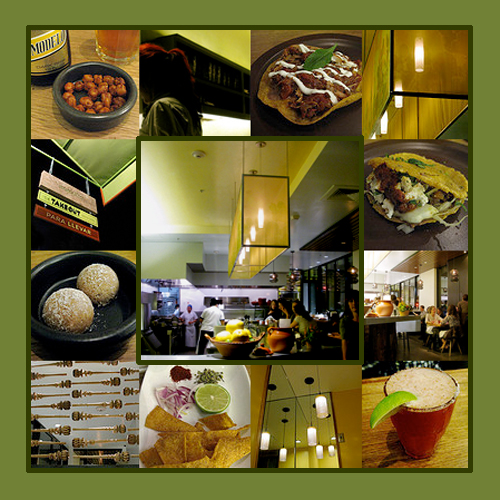
I don’t think it’s any secret here that we’re big fans of puns, wordplay, and other clever banter, so you’ll probably guess that I’ve been gaga about the wittly named Nopalito — the casual Mexican offspring of our beloved Nopa — since the day I first learned it was coming to town.
It’s also no great surprise that an authentic Mexican restaurant would be a huge draw for me, the girl who would happily scarf chilaquiles for breakfast, tortas for lunch, and a big cheesy combination platter for dinner. But here’s the icing on the cake: Nopalito follows the same local-seasonal-sustainable-organic-ethical blueprint as its older sibling, and it does it in style.
Now, we’re not much for restaurant reviews these days, but I will say this: Nopalito is off to a running start, and we’re looking forward to many return trips. As Cameron said: “This place is pretty much the restaurant you’ve been waiting for… forever.” He’s right: There’s very few places like Nopalito in the Bay Area — Doña Tomas is about the nearest equivalent — and certainly nothing of its type within The City proper.
 Do I like the hour-long waits? No. (But I’m soothed by being able to call ahead and put my name on the list.) Do I like perching on barstools, elbow-to-elbow with perfect strangers at a communal table? Not one bit. (But on the other hand, it’s prime Eatsdropping territory, and a not-bad way to decide what you want to order next.) Am I enthralled with everything I ate on our first visit? Not by a long shot.
Do I like the hour-long waits? No. (But I’m soothed by being able to call ahead and put my name on the list.) Do I like perching on barstools, elbow-to-elbow with perfect strangers at a communal table? Not one bit. (But on the other hand, it’s prime Eatsdropping territory, and a not-bad way to decide what you want to order next.) Am I enthralled with everything I ate on our first visit? Not by a long shot.
But there were enough promising tastes on our first visit — the gordita de picadillo first among them — that absolutely transported me. I’m looking forward to seeing what else they have in store, especially once the weather warms up enough to enjoy a Michelada or two on the covered patio.
Nopalito
306 Broderick Street
(x Fell/Laguna)
San Francisco, CA
415-437-0303
Dark Days challenge, locavore, Mexican, restaurants
5 Comments »




Posted by Anita on 02.16.09 11:52 PM
 The great irony of these troubled economic times is that cocktail budgets are shrinking just at the time when many of us really could use a strong drink. And even if you’ve survived the entire economic downturn syndrome — the downsizing, the furloughs, the real-estate bubble, and the credit crunch — unscathed, it feels a little too much like tempting fate to be drinking high on the hog while waiting for the other shoe to drop.
The great irony of these troubled economic times is that cocktail budgets are shrinking just at the time when many of us really could use a strong drink. And even if you’ve survived the entire economic downturn syndrome — the downsizing, the furloughs, the real-estate bubble, and the credit crunch — unscathed, it feels a little too much like tempting fate to be drinking high on the hog while waiting for the other shoe to drop.
And thus we find ourselves on this particular Mixology Monday with the theme Hard Drinks for Hard Times, hosted by whiskey guru Matthew Rowley. Our assignment: “Write about an alcoholic drink you’ve made that resonates with the current economic turndown.”
But even widespread austerity measures don’t have to mean the end of the civilized ritual that a properly made cocktail affords. Off the top of my head, I can think of five painless ways to keep the cocktail hour rolling when we need it the most:
Secret #1: Switch your allegiance.
Perhaps the simplest way to economize on cocktail expenses — other than to drink less — is to drink cheaper booze. Duh. But I’m not advocating that you ignore your tastebuds and buy crap, or even settle for something you don’t enjoy. (We are still drinking for the pleasure of the well-crafted cocktail, correct?)
So, for example, if you’re fond of rye (and really, who isn’t?) consider a bottle of Old Overholt for everyday mixing; save that Sazerac or Rittenhouse for sipping, or at least for the drinks where the spirit is the star of the show. The shelves are filled with quality booze that’s nearly as good as the boutique brands, at a fraction of the cost. David Wondrich wrote up five of his favorites in a recent Esquire piece; I’m hoping we’ll hear a lot more about alternative brands from other MxMo posters.
Secret #2: Share the love.
If you need just an ounce or two of some obscure liqueur, don’t be afraid to ask your friends if they’ve got a bottle you can borrow. This works especially well if you have somebody like Erik living a few blocks away, like we do. But even if you have to make a special trip across town, you’ll have an excuse to buy your pal a drink.
The ground rules are the same ones your mama taught you back when your friends were loaning you Hot Wheels and Shaun Cassidy albums: Return the item in the same condition you found it, express gratitude in an appropriate fashion, and reiterate how happy you’ll be to return the favor down the road.
 Secret #3: Think small.
Secret #3: Think small.
If you don’t have a ready network of cocktail geeks in your back yard, there’s still hope. Even the most math-challenged among us realizes that mini-bottles aren’t a great deal on an ounce-by-ounce basis. But if you only need a splash of something to test out a recipe – especially if it’s a type of liquor you aren’t sure you’ll love – tiny bottles can be a smarter bet.
A case in point: A few months back, I wanted to test a recipe that called for a small amount of Southern Comfort. But I’m not a great fan of flavored spirits, so this was a case where the $2.50 mini was a much wiser investment than the 750ml bottle at $15. (Special note to drink bloggers: Minis are often indistinguishable from their full-size counterparts in photographs, especially if you use a macro lens.)
Secret #4: Shop around.
If you’re lucky enough to live in a place that’s unencumbered by a state liquor monopoly, don’t be afraid to look for good-quality booze in unlikely places. Swanky spirits emporia may have all the beautiful bottles you need in one place, but they aren’t always a fantastic bargain. And — if you’re anything like me — it’s often impossible to get out the door without buying three (or five, or a dozen) things you couldn’t live without.
You can often find great deals at places that don’t necessarily specialize in spirits, like supermarkets (we keep our Safeway Club Card just for stocking up on staple booze), drugstores (a co-worker swears Rite-Aid has door-buster pricing on Sailor Jerry rum), and warehouse stores like Costco. Just make sure to walk straight past that twelve-pack of Swiffer refills, OK?
But when you’re clipping coupons and being an otherwise savvy consumer, don’t forget that the owner of your local quality liquor store — the one who makes great wine recommendations and offers to set aside bottles of special whiskey for you when it comes in — is also feeling the pinch. Certainly, buy your Beefeater in bulk, but when you’re getting excited about saving two bucks on a $25 bottle at the megamart, remember that if you don’t buy from the folks who really know their stuff, you’ll miss their expertise when the inevitable happens.
Secret #5: Drink seasonally.
If you’re a fan of drinks that have a substantial fruit or juice component, it pays to keep an eye on the calendar. Drink sours in the wintertime, Tequila por mi Amante in the spring, Bellinis in summertime, cobblers in the fall. Just as when you’re planning meals, follow the bumper crop for cocktail ingredients and you’ll find the best prices as the farmers market. And don’t be afraid to ask around; you may even get lucky enough to find a neighbor or co-worker with an abundance of backyard fruit to share.
If you know you won’t be able to live without your favorite fruity beverages in the off-season, consider simple preservation: Most fruits (and pretty much all juices) freeze well, and home-made cocktail cherries are among the simplest and most rewarding of spring pantry projects.
—-
In the spirit of the frugal tipple, we shook up a batch of Ward Eight cocktails — essentially a more-interesting twist on the venerable whiskey sour — using one of our favorite value-priced spirits, plus lemons from our own tree, and oranges given to us by a friend with an abundance of homegrown fruit. The grenadine is a homebrew version we keep on hand, made from store-bought pomegranate juice. The cherry garnish happens to be a gift from another thoughtful friend, but we could just as easily have used our own home-preserved version.
We’re sipping them out of gorgeous glassware, but — a-ha, an unbilled Secret #6! — we buy nearly all of our cocktail glasses secondhand. Thrift stores sell beautiful vintage glasses as cheaply as $0.50, and rarely higher than $2 a stem. An added bonus: Antique cocktail glasses are much smaller than their modern counterparts, so you can often split a single drink between two.





Ward Eight
2 oz rye whiskey (such as Old Overholt)
3/4 oz lemon juice
3/4 oz orange juice
1 teaspoon grenadine
Shake with ice and strain into a chilled cocktail glass.
drinks, Mixology Monday, recipes
14 Comments »




Posted by Anita on 02.09.09 10:52 PM
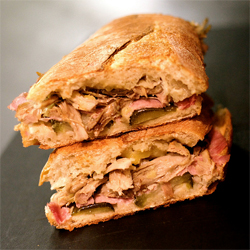 I keep teasing you about the pig roast, and — I’m sorry — this isn’t going to be that post, either. I’d like to say that it was such an epic event that I’m still wrapping my brain around it, or maybe that I am still trying to choose among the fabulous photos our friends took to illustrate the post.
I keep teasing you about the pig roast, and — I’m sorry — this isn’t going to be that post, either. I’d like to say that it was such an epic event that I’m still wrapping my brain around it, or maybe that I am still trying to choose among the fabulous photos our friends took to illustrate the post.
In truth, my only excuse is that we had a rather… dramatic weekend, including one night that didn’t end until 4:30 the next morning — for entirely not-fun reasons. We’re all fine now, but all the drama meant there wasn’t a lot of time for rest, reflection, or anything resembling creativity, either in the kitchen or at the computer.
Luckily, there was a freezer full of pig-roast leftovers, which is like money in the bank as far as I’m concerned. Even with sleep-deprived brains, we knew well enough to thaw out a bag of pulled pork to feed our weary bones. On Sunday morning, Cameron pulled together another one of his famous hash-and-eggs brunches with part of the meat; later on, we dug up a couple of Acme grinder rolls and made Cubanos with the rest.
These Cuban-style pressed sandwiches — roast pork, ham, cheese, pickles, and mustard, all smooshed together into a crunchy-soft-chewy miracle — are just the sort of thing we want to eat when we need a little cheering up. If you happen to have some cabbage and carrots and onions around, I can vouch that Cubanos are pretty tasty with a quick slaw; all you need is mayo, cider vinegar, salt and pepper. Otherwise, a cup of black-bean soup would not be out of place, nor would a handful of banana chips.
 If you don’t have a freezer full of pulled pork (pobrecito!) you can substitute leftover roast chicken, or even leave out the roast meat completely. To compensate, add a little extra ham and cheese and you’ve got the makings of another venerable Cuban sandwich: the Medianoche — named, so they say, for the midnight hours when many are consumed, to fuel up for another round of late-night dancing or drinking.
If you don’t have a freezer full of pulled pork (pobrecito!) you can substitute leftover roast chicken, or even leave out the roast meat completely. To compensate, add a little extra ham and cheese and you’ve got the makings of another venerable Cuban sandwich: the Medianoche — named, so they say, for the midnight hours when many are consumed, to fuel up for another round of late-night dancing or drinking.
You may read otherwise elsewhere, but you don’t need any special equipment to make a Cubano — though I am sure a panini press would be handy, if you happen to have one. Once you have all the ingredients on hand, a Cubano is simple to make, and it’s comfort food of the highest order. And really, couldn’t you use a little coddling?
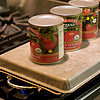



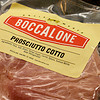
Cuban Sandwiches
– adapted from Kitchen Sense
2 rustic sandwich rolls, about 6″ (or half a wide-ish baguette)
2-4T mustard
2T mayonnaise (optional)
1 whole kosher dill pickle
4 slices ham
4oz roast pork (or chicken), shredded
2 slices mild cheese (such as Jack or a mild Swiss)
Preheat a large cast-iron skillet or a griddle over medium heat.
Slice the pickle lengthwise into four pieces, and set aside. Cut the rolls lengthwise, leaving the back side attached as a hinge. Open the rolls up and spread a light layer of mustard on the inside bottom. If using mayonnaise (which I recommend unless your pork is very juicy), spread an even layer on the inside top half of each roll.
For each sandwich: Place two pickle slices on top of the mustard, then top with a slice of ham and half of the pulled pork. Top with a slice of cheese, and close up the sandwich.
Place the sandwiches on the preheated skillet or griddle, and press down with a wide spatula. Top the sandwiches with a cookie sheet or a second skillet, and weight down (big tomato cans work well). Cook for 4 minutes, pressing down firmly on the weights every minute or so.
Using hotpads, remove the cookie sheet. Turn the sandwiches over and replace the sheet and weights, again pressing down firmly. The liquid from the pickles and ham will sizzle a little bit; this is a good sign. Cook for another 4 to 5 minutes, until the top of the roll is crispy and the cheese is melted. Remove from the pan and cut each sandwich in half; serve immediately while hot.
Dark Days challenge, locavore, meat, recipes
6 Comments »




Posted by Anita on 02.06.09 9:36 PM
 I know that it’s been awfully quiet around these parts for a while, but whirlwind trips to New York City will severely cut into your blogging time. The lovely folks at NOTCOT and Liqurious sent me on a hybrid photography/writing assignment to cover the launch of Rosangel, a new hibiscus-infused tequila from Gran Centenario.
I know that it’s been awfully quiet around these parts for a while, but whirlwind trips to New York City will severely cut into your blogging time. The lovely folks at NOTCOT and Liqurious sent me on a hybrid photography/writing assignment to cover the launch of Rosangel, a new hibiscus-infused tequila from Gran Centenario.
You can probably guess that I don’t have a lot of personal affection for flavored spirits, but my better judgment prevailed: As freelance gigs go, getting to visit New York for a long weekend sure beats the hell out of just about anything else.
I fretted about how to make a rose-pink tequila sound credible to our cocktailian friends. But in all honesty, from what I was able to taste at the event, Rosangel has all the hallmarks of a quality product. It uses Gran Centenario reposado as its base, it’s aged for an additional 2 months in port casks to give it complexity and a rosy glow, and then it’s infused with hibiscus blossoms, not doctored with artificial flavors. I’m anxiously awaiting the chance to get my hands on a bottle to play with; the retail launch is set for March.
What I didn’t know when I accepted the assignment was that one of the events would be held at Clover Club, the newish Brooklyn bar from Julie Reiner of Flatiron Lounge fame. And, better still, that I’d have a chance to watch Ms. Reiner and Paul Pacult lead a hands-on immersion training for eight tequila-loving bartenders flown in from all around the country. (I won’t steal my own thunder any more than I already have: You’ll have to check out the NOTCOT post for the full scoop.)
So anyway, apologies for the radio silence. At least you know I had a good excuse! I promise there’s another post coming soon, all about the 70-pound pig we roasted for Cameron’s big birthday.





(Oh man, I shot so many frames… picking just five representative photos for the filmstrip this time is impossible! Please click through to see the whole collection.)
bar culture, drinks, NYC, other blogs
6 Comments »




Posted by Anita on 01.28.09 9:16 PM
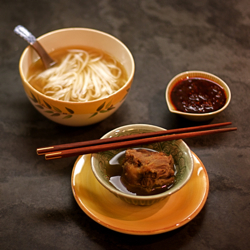 We usually consume our oxtails in an Italian-style ragu. But with Chinese New Year upon us — and the Year of the Ox, at that — it seemed like an Asian preparation would be more appropriate.
We usually consume our oxtails in an Italian-style ragu. But with Chinese New Year upon us — and the Year of the Ox, at that — it seemed like an Asian preparation would be more appropriate.
In the world of Chinese oxtail recipes, the options generally boil down to either a hearty braise with root vegetables, or a simple long-simmered soup. In the latter, the meat is simmered for hours until it’s meltingly tender, then served in two parts, much like a French pot-au-feu: a platter of meat with a piquant dipping sauce, and a bowl of clear broth to fill the belly and provide a respite from the spicy, meaty main.
Usually, rice would accompany the meat, but in the spirit of the New Year celebration, we opted to add noodles — which signify long life — to the broth. If you’re not so keen on eating out of two separate bowls, you can pull the meat off the oxtails and stir it in with the noodles and broth, then serve with the sauce on the side for each diner to stir in as she chooses.

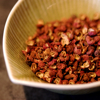



Sichuan Oxtail Soup
– adapted from Land of Plenty and Classic Food of China
2-1/2 to 3 pounds of meaty oxtail
2 chicken drumsticks (or any two pieces of dark meat)
3- to 4-inch piece of fresh ginger, unpeeled
2 tsp whole Szechuan peppercorns
1/2 cup Shaoxing wine (or medium-dry sherry), divided use
6-8 oz dry rice noodles (your choice of width)
salt to taste
– Sauce
1T peanut oil
1/4 cup Sichuan-style chili bean paste
2 tsp dark soy sauce
2 tsp sesame oil
Soak the oxtail pieces in cold water for 30 minutes, then discard the soaking water.
In a large, heavy-bottomed pan, bring 3 quarts of water to a boil. Add the oxtail and chicken, and return to a boil. Skim off any foam that floats to the top, then reduce heat to maintain a steady simmer, stirring occasionally and adding water as needed to keep the oxtails mostly submerged.
Smash the ginger with the back of a knife or other heavy object. Add it to the pan along with the peppercorns and 1/4 cup of the Shaoxing wine. Partially cover the pan, and simmer for at least 3 hours.
Meanwhile, prepare the sauce: Heat the peanut oil in a wok or skillet until very hot but not smoking. Add the chili bean paste, and stir fry until the oil is deep red and the sauce is fragrant. Pour the sauce into a heatproof bowl; when cooled, add the soy sauce and sesame oil.
At the end of the simmering time, the oxtail should be very tender and the meat will pull away from the bone but not completely separate from it. Remove the oxtails to a plate, discarding the simmered-out chicken parts. Pick off any peppercorns that stick to the oxtails and discard. Drain the broth through a fine seive, discarding the peppercorns and ginger, and return the clear dark broth to the pot. You should have about 6-8 cups of soup at this point; add additional cold water if needed, or simmer down the broth. Once you have the proper quantity, add the remaining 1/4 cup Shaoxing wine, then salt the broth to taste. Return the oxtails to the pan and gently reheat until very hot. (If you want to serve the soup in one bowl, pick the meat from the bones before returning it to the broth.)
Meanwhile, prepare the rice noodles according to package directions. (Usually this involves soaking the noodles in boiling water, as opposed to simmering them.) When cooked, divide the noodles among 4 soup bowls, then ladle the hot broth over them. Serve the oxtails in a separate large bowl or tureen, moistened with a bit of the broth, and allow each diner to choose their piece, eating it out of a rice bowl by pulling the meat off the bone and dipping it in the sauce to taste.
holidays & occasions, meat, recipes
10 Comments »




 Two weekends ago, I nearly lost a toe.
Two weekends ago, I nearly lost a toe. I sat down and quickly mapped out 14 meals we could easily make by combining two or more components of the freezer. (Beef plus chorizo plus buns equals Sloppy Joes. Beans plus pork plus sausage equals Cassoulet.) And that wasn’t even counting the dozen or so ready-to-eat meals — like beef stew, coq au vin, and chili — that we’d set aside. I quickly realized we could go for weeks, eating very well without buying anything but fresh vegetables.
I sat down and quickly mapped out 14 meals we could easily make by combining two or more components of the freezer. (Beef plus chorizo plus buns equals Sloppy Joes. Beans plus pork plus sausage equals Cassoulet.) And that wasn’t even counting the dozen or so ready-to-eat meals — like beef stew, coq au vin, and chili — that we’d set aside. I quickly realized we could go for weeks, eating very well without buying anything but fresh vegetables.









 Now, I don’t know where you go for good Cajun and Creole recipes, but my first (and last) source is Chuck Taggart’s fabulous
Now, I don’t know where you go for good Cajun and Creole recipes, but my first (and last) source is Chuck Taggart’s fabulous 












 The great irony of these troubled economic times is that cocktail budgets are shrinking just at the time when many of us really could use a strong drink. And even if you’ve survived the entire economic downturn syndrome — the downsizing, the furloughs, the real-estate bubble, and the credit crunch — unscathed, it feels a little too much like tempting fate to be drinking high on the hog while waiting for the other shoe to drop.
The great irony of these troubled economic times is that cocktail budgets are shrinking just at the time when many of us really could use a strong drink. And even if you’ve survived the entire economic downturn syndrome — the downsizing, the furloughs, the real-estate bubble, and the credit crunch — unscathed, it feels a little too much like tempting fate to be drinking high on the hog while waiting for the other shoe to drop.























